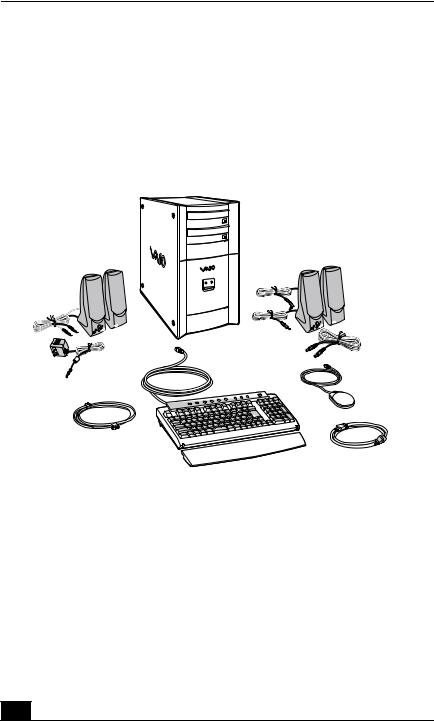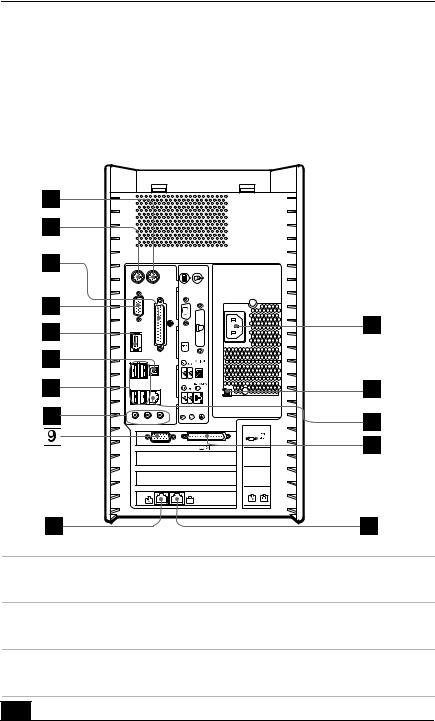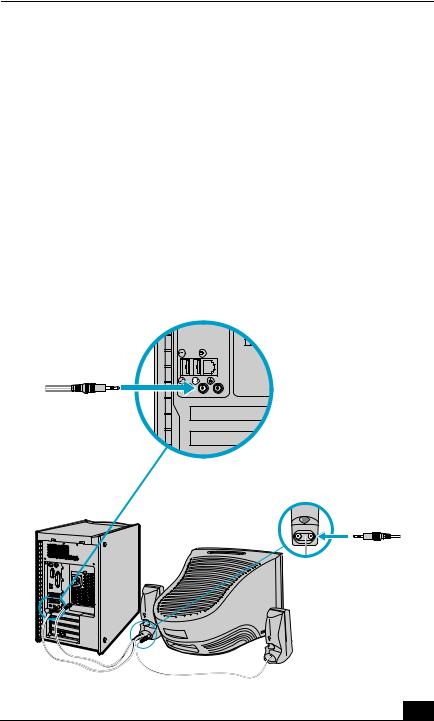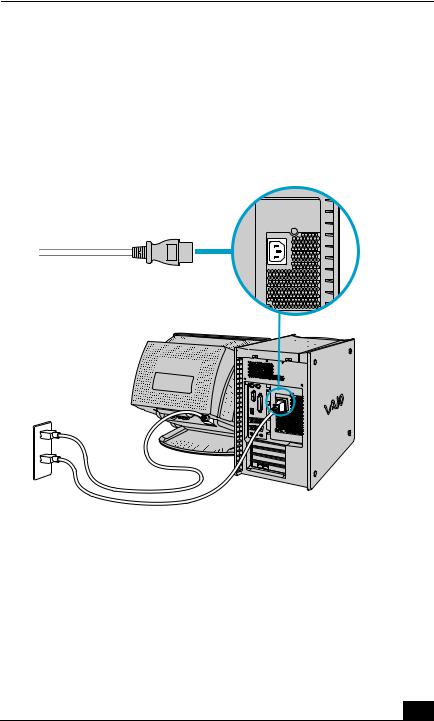Sony PCV-7762 User Manual

VAIO Digital Studio™
Computer Quick Start

Contents
Getting Started ............................................ |
5 |
Unpacking Your Computer ......................................... |
6 |
Planning An Ergonomic Work Space ......................... |
8 |
Locating Controls And Ports ..................... |
9 |
About The Front Panel .............................................. |
10 |
About The Back Panel............................................... |
12 |
Setting Up Your Computer ....................... |
15 |
Connecting A Display (Monitor) .............................. |
16 |
Connecting The Speakers.......................................... |
17 |
Connecting The Keyboard And Mouse..................... |
19 |
Connecting The Telephone And Modem Cables...... |
20 |
Connecting The Power Cord(s)................................. |
21 |
Turning On Your Computer...................................... |
22 |
Registering Your Computer ...................................... |
23 |
Setting Up Your Dial-up Connection........................ |
24 |
Turning Off Your Computer ..................................... |
27 |
3 |

VAIO Digital Studio Computer Quick Start |
|
System And Application |
|
Recovery CD(s) ......................................... |
29 |
Using The System Recovery CD(s).......................... |
30 |
Using The Application Recovery CD(s)................... |
33 |
Troubleshooting........................................ |
37 |
About VAIO Computer Functions............................ |
38 |
About Software ......................................................... |
42 |
About Using The Optical Disc Drive(s) ................... |
46 |
About The Speakers.................................................. |
49 |
About The Modem.................................................... |
50 |
About The Microphone............................................. |
52 |
About The Mouse And Keyboard............................. |
53 |
About Using Peripheral Equipment.......................... |
55 |
Support Options........................................ |
57 |
Immediate Help And Support ................................... |
58 |
Software Help And Support...................................... |
60 |
Contacting Sony For Help And Support................... |
63 |
Notice........................................................................ |
65 |
Index........................................................... |
73 |
4 |

Getting Started
Congratulations on your purchase of the Sony VAIO® computer! Your new, high-performance, multimedia computer combines audio, video, and information technology features.
5 |

VAIO Digital Studio Computer Quick Start
Unpacking Your Computer
Your computer may not be supplied with all of the accessories shown, depending on the system configuration you purchased. For details on the accessories supplied with your computer, see the online Specifications sheet.
Computer and supplied accessories
|
System Unit |
Speakers* |
Speakers* |
(PCVA-SP3) |
(PCVA-SP3A) |
with AC Adapter |
with Speaker Power Cable |
Keyboard |
Mouse |
Modem Cable |
|
|
Power Cord |
* The supplied speakers may vary, depending on the VAIO computer model purchased. See the online specifications sheet for details on supplied accessories.
6 |

Unpacking Your Computer
Manuals
VAIO Digital Studio™ Computer Quick Start — Provides basic information on setting up and registering your computer. The Quick Start also provides software, support, safety and legal information.
VAIO Digital Studio™ Computer User Guide — Contains information on the hardware and preinstalled software applications included with your system. To access the online manual:
1 Click Start in the Windows taskbar, then click Help and Support. 2 From the VAIO Help and Support menu, click VAIO User Guide.
Specifications — This online specification sheet describes the hardware and software configuration of your VAIO computer. To view this online information:
1 Click Start in the Windows taskbar, then click Help and Support.
2 From the VAIO Help and Support Center menu, click VAIO User Guide.
3 Click the Welcome link. The Welcome page displays in the right-side frame.
4 Click the link in the text, “View the VAIO Computer Specifications, which lists your computer's hardware configuration and preinstalled software information.”
Microsoft® Windows® XP Guide — Explains how to use the basic features of the latest Windows operating system.
Recovery CDs
System Recovery CD(s) — Restore the software applications that shipped with your computer if they become corrupted or are erased. The supplied System Recovery CDs can only be used to restore the hard disk of this Sony computer.
Application Recovery CD(s) — Reinstalls individual software applications or drivers if they become corrupted or are erased.
Other
Packet containing special product offers.
Software Library containing the Microsoft software license agreement and Sony end-user license agreement.
7 |

VAIO Digital Studio Computer Quick Start
Planning An Ergonomic Work Space
Before you set up your new computer, find the best location for your new computer and plan your work space. There are several ergonomic factors to consider when you arrange your work space:
Stable work surface — Use a stable work surface large enough to support the computer and other peripheral equipment.
Ventilation — Leave at least eight inches of space on the left and back sides of your computer to enable proper ventilation.
Placement of the keyboard, mouse, and other input devices — Place your keyboard, mouse, and other input devices so that your arms and hands are in a relaxed, comfortable position. The keyboard should be directly in front of you. Adjust the level of the keyboard so that your lower arms are parallel to the floor. Keep your wrists in a relaxed position when you are using the keyboard—not angled up or down. Use the palmrest only briefly, for resting. Position the mouse at the same level as the keyboard. Hold the mouse with a relaxed hand, and use your whole arm to move it. Take breaks during sessions with your computer. Excessive use of the mouse or a joystick may strain muscles or tendons.
Furniture and posture — Sit in a chair with good back support and armrests. Adjust the level of the chair so your feet are flat on the floor. A footrest may make you more comfortable. Sit with relaxed, upright posture—avoid slouching forward or leaning far backward.
Viewing angle of the display — Position the display 18 to 26 inches directly in front of you, with the top of the screen at or a little below eye level. Use the display’s tilting feature to find the best position. You can reduce eye strain and muscle fatigue by placing the display in the proper position.
Lighting — Choose a location where windows and lights do not create glare and reflection on the display. Use indirect lighting to avoid bright spots on the display. You can also purchase accessories for your display that help reduce glare. Proper lighting adds to your comfort and work effectiveness.
8 |

Locating Controls And Ports
This section is intended to familiarize you with the controls, ports and jacks that may be available on your computer.Your computer may not be equipped with all of these hardware features and the location of the controls, ports, and jacks may vary from the illustrations shown in this section. To view the specific connection capabilities for your system, see the online specifications sheet.
i.LINK is a trademark of Sony used only to designate that a product contains an IEEE 1394 connection. The i.LINK connection may vary, depending on the software applications, operating system, and compatible i.LINK devices. All products with an i.LINK connection may not communicate with each other.
Please refer to the documentation that came with your compatible i.LINK device for information on operating conditions and proper connection. Before connecting compatible i.LINK devices to your system, such as an optical or hard disk drive, confirm their operating system compatibility and required operating conditions.
9 |

VAIO Digital Studio Computer Quick Start
About The Front Panel
The front panel of your VAIO Computer enables access to the optical and floppy disk drives. It also includes access to the Memory Stick media slot, Universal Serial Bus (USB), and i.LINK® ports to connect compatible peripheral devices.
Front panel
1Optical drive 1
See the online specifications sheet for optical drive information.
2Optical drive 2
See the online specifications sheet for optical drive information.
3Floppy disk drive
Reads and writes data from and to a 3.5-inch floppy disk.
10 |

About The Front Panel
4Floppy disk drive access indicator
Light is green while reading and writing data from and to a floppy disk.
5Optical drive access indicator
Light is amber while reading and writing data from and to the optical drives.
6Hard disk drive access indicator
Light is amber while reading and writing data from and to the hard disk.
7Power switch and power indicator
Turns the computer on/off. The indicator light is blue while the power is on and amber when the computer is in Stand by mode.
8i.LINK 4-pin port (IEEE 1394)
Connection for a compatible digital device.
9Optical drive 1 eject button
Ejects a disc from Optical drive 1.
10Optical drive 2 eject button
Ejects a disc from Optical drive 2.
11Memory Stick® media slot
Reads and writes data from and to a Memory Stick media.
12Floppy disk eject button
Ejects a floppy disk.
13Universal Serial Bus (USB) 2.0 ports (4)
High-speed connections for compatible USB devices.
For your convenience, your computer includes USB and i.LINK ports on both the front and back panels. The 4-pin i.LINK port is located on the front panel and the 6-pin i.LINK port is located on the back.
11 |

VAIO Digital Studio Computer Quick Start
About The Back Panel
The back panel of your computer contains the ports for supplied and optional accessories. The icons on the back panel locate and identify the ports and jacks on your computer.
Back panel
KEYBOARD MOUSE |
|
||
MONITOR |
|
|
|
|
PRINTER |
|
|
i.LINK |
|
|
|
S400 |
|
|
|
|
|
ACT |
|
|
|
LINK |
|
MIC |
HEADPHONES |
LINE IN |
|
|
|
4 |
|
|
|
MONITOR |
|
MONITOR |
|
3 |
|
|
|
|
|
|
|
2 |
|
|
|
1TELEPHONE |
LINE |
1Mouse port
Connection for a PS/2® mouse.
2Keyboard port
Connection for a PS/2 Keyboard.
3Printer port
Connection for a parallel device, such as a printer or scanner.
12 |

About The Back Panel
4Monitor port (The monitor port location may vary between models)
Connection for a standard display.
5i.LINK 6-pin port (IEEE 1394)
Connection for a compatible digital device.
6S/P DIF optical out port
Connection for a digital audio or optical device.
7Universal Serial Bus 2.0 (USB) ports (4)
Connection for compatible USB devices.
8Microphone jack
Connection for a microphone (optional).
Headphones jack
Connection for the supplied speakers or optional headphones.
Line In jack
Connection for an audio device.
9Monitor port (The monitor port location may vary between models)
Connection for a standard display.
10Telephone jack
Connection for a telephone cable (optional) to the computer.
11AC Input port
Connection for the supplied power cord.
12Speaker DC Out jack (For use with PCVA-SP3A speakers*)
Connection for the speaker power cable.
13Ethernet port
Connection for a 10BASE-T/100BASE-TX Ethernet.
(The port marked with  (Network) is for LAN connections only.)
(Network) is for LAN connections only.)
14Monitor (DVI) port (DVI port is not available on all models)
Connection for a DVI monitor.
15Modem line jack
Connection for the supplied modem cable to the wall jack.
* The speaker model supplied with your computer may vary, depending on the system |
13 |
purchased. See the online specification sheet for information on supplied accessories. |

VAIO Digital Studio Computer Quick Start
14

Setting Up Your Computer
Your computer may not be equipped with all of these hardware features, therefore, some instructions may not apply to your specific computer. The location of the controls, ports, and jacks may vary from the illustrations shown in this section. See the online specifications sheet for your system's configuration.
15 |

VAIO Digital Studio Computer Quick Start
Connecting A Display (Monitor)
1Plug the display cable into the monitor port*.
2If necessary, plug the display cable into the rear of the display.
To connect a display
Install your equipment so that you can easily reach the power outlet in the event of an emergency.
*Your computer may have an available DVI monitor port for use with a DVI monitor. Do not attempt to connect a standard VGA monitor to the DVI monitor port.
16 |

Connecting The Speakers
Connecting The Speakers
Connecting the PCVA-SP3A speakers (with a speaker power cable)
1Plug the cable attached to the back of the left speaker into the L Out jack on the back of the right speaker.
2Plug the cable attached to the back of the right speaker into the Headphones jack, located on the back panel of your computer.
3Plug the jack end (yellow) of the speaker power cable into the DC In jack (yellow) on the back of the right speaker.
4Plug the jack end (black) of the speaker power cable into the DC Out jack located on the back panel of your computer.
To connect the PCVA-SP3A speakers
USB |
NETWORK |
|
ACT |
|
LINK |
MIC |
HEADPHONES LINE IN |
17 |

VAIO Digital Studio Computer Quick Start
Connecting the PCVA-SP3 speakers (with an AC adapter)
1Plug the cable attached to the back of the left speaker into the L Out jack on the back of the right speaker.
2Plug the cable attached to the back of the right speaker into the Headphones jack.
3Plug the jack end of the AC adapter cord into the DC In jack on the back of the right speaker and plug the other end into a grounded AC wall outlet or power strip.
18 |

Connecting The Keyboard and Mouse
Connecting The Keyboard And Mouse
1Plug the keyboard cable into the keyboard port on the back of the computer.
2Plug the mouse cable into the mouse port.
To connect the keyboard and mouse
19 |

VAIO Digital Studio Computer Quick Start
Connecting The Telephone And Modem Cables
1Unplug your telephone from the wall jack.
2Plug the modem cable (supplied) into the Modem line jack on the computer, and then plug the other end of the cable into the wall jack.
To connect the telephone and modem cables
Your computer has a protective sticker  covering the Ethernet port located on the rear panel. Connect only 10BASE-T and 100BASE-TX cables to the Ethernet port. Using other cables or a telephone cable may result in an electric current overload and can cause a malfunction, excessive heat or fire in the port. For help on connecting to a network, see your network administrator.
covering the Ethernet port located on the rear panel. Connect only 10BASE-T and 100BASE-TX cables to the Ethernet port. Using other cables or a telephone cable may result in an electric current overload and can cause a malfunction, excessive heat or fire in the port. For help on connecting to a network, see your network administrator.
20 |

Connecting The Power Cord(s)
Connecting The Power Cord(s)
1Plug the power cord into the back of the computer.
2Plug both the display and power cords into a grounded AC wall outlet or a power strip.
To connect the power cords
21 |

VAIO Digital Studio Computer Quick Start
Turning On Your Computer
When you start your system for the first time, your computer may detect new equipment and display a dialog box that prompts you to restart your computer. Respond to this prompt immediately.
1Press the power switch on the computer to turn on the power.
2Press the power switch on the display to turn on the power.
3Press the power switch on the right speaker to turn on the power.
To turn on your computer
22 |

Registering Your Computer
Registering Your Computer
Take advantage of Sony’s commitment to quality customer support and receive these benefits by registering your computer:
Sony Customer Support — Communicate with a Support Representative to troubleshoot problems you may be having with your computer.
Limited warranty — Protect your investment. See the Warranty Card for more details.
You are prompted to register your computer the first time you turn on the unit. Follow the on-screen instructions to complete the registration process. If you are not able to register your computer during the first session, you are provided with additional registration opportunities later.
23 |

VAIO Digital Studio Computer Quick Start
Setting Up Your Dial-up Connection
The first time you turn your computer on, follow these steps to set up your dialup connection:
1Click Start from the Windows taskbar and select All Programs.
2Point to Accessories, point to Communications, and then click New Connection Wizard. The Location Information window appears.
Location Information window
3Enter in your information as requested. Click OK. The Phone and Modem Options window appears.
24 |
